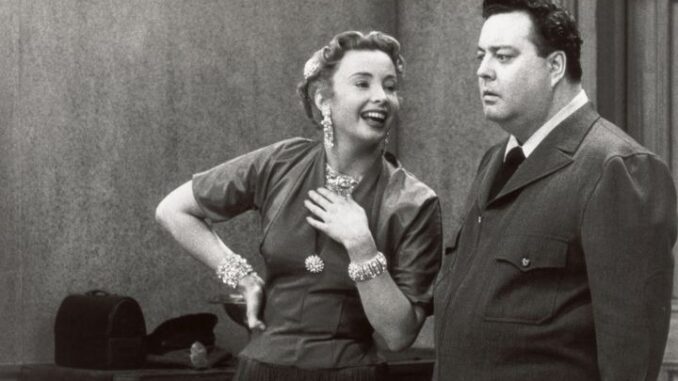
How sweet it is: “The Honeymooners” on MeTV

In the final episode of the first season of AMC’s Mad Men, set in 1960, advertising wunderkind Don Draper pitches his creative concept to Kodak for its latest product, a slide projector called the Carousel. He speaks of the power of nostalgia and describes the device as a time machine with the ability to take people to that place everyone most longs to go, “back home again.” As he delivers his presentation in a darkened conference room, images of Draper’s own young wife and children flash onto a screen one by one, and the carousel works its magic on on those who watch.
MeTV is another sort of time machine. Its viewers are regularly transported to an earlier, some say more golden, age of television – the ‘50s, ‘60s and ‘70s, those decades when the network’s target audience, baby boomers like me, was very young. Tripping into the past by way of MeTV is a purely cheerful experience, nothing at all like the harrowing journey of Martin Sloan (Gig Young) whose “Walking Distance” detour into his past took him through the looking glass of The Twilight Zone.
Thanks to MeTV I’ve once again been able to travel The Streets of San Francisco and revisit The Rockford Files, The Dick Van Dyke Show, Mary Tyler Moore and, most recently, Rhoda – all great and legendary series. But the show I can never resist, no matter how many times I’ve seen it, is The Honeymooners, the classic 39 episodes that aired on CBS from 1955 – 56. Since it airs on MeTV at 1:30 a.m. PDT these days, I’ve got the DVR up and running in the middle of the night just so I can savor the antics of Ralph and Alice Kramden (Jackie Gleason and Audrey Meadows) and Ed Norton (Art Carney) a time or two more.
Everyone in my family was a big fan of Jackie Gleason and we were crazy about his Ralph Kramden, the supersized New York bus driver, a man with “big ideas” and dreams of becoming a “big shot” one day. We got a kick out of Ed Norton, the quirky sewer worker who was Ralph’s neighbor and best friend, and adored long-suffering Alice Kramden, purveyor of sparingly dispensed but devastating wisecracks, who knew well that beneath Ralph’s bluff and bluster he was a big-hearted softy. The Honeymooners ran on television in one form or another from the early ‘50s into the late ‘70s, so it’s fair to say that it was always in the background of our lives as my brother and I grew up.

The Honeymooners made its first TV appearance as a comedy sketch on Cavalcade of Stars, a variety show Jackie Gleason hosted on the now-dufunct DuMont Network from 1950 – 1952. When he was hired away by CBS in 1952 and began the enormously successful Jackie Gleason Show, The Honeymooners continued as a regular sketch within the show. It was wildly popular and became an increasingly more prominent part of the program, so when Gleason decided to take a break from the hour-long variety show format, it became a stand-alone half-hours series from 1955 – 56. The 39 episodes from that season came to be referred to as “the Classic 39.” When Gleason resumed the variety show format for a final season, 1956 – 57, The Honeymooners became, once more, a sketch segment.
In 1962 Jackie Gleason returned to TV following a hiatus with his American Scene Magazine (1962 – 1966). The Honeymooners was occasionally featured as part of this variety show. Sue Ane Langdon would appear as Alice in two 1962 sketches and Audrey Meadows would return as Alice in an hour-long 1966 musical sketch.
Beginning with the 1966 – 67 season and through the remainder of its run until 1970, The Jackie Gleason Show was filmed in color and The Honeymooners installments of this era are known as “the Color Honeymooners.” Sheila MacRae portrayed Alice in these mostly mini-musical episodes.
From 1970 – 1978, The Honeymooners aired as a series of nearly annual specials with Audrey Meadows returning as Alice in 1976. Finally, in 1985, a Honeymooners reunion special was broadcast in May and an anniversary special aired in October.
Of all the show’s incarnations, it’s the early Honeymooners I’m forever drawn to. Part of this, of course, is about the pure quality of the show during that period when it was at its peak. But another part of the attraction has to do with memories of nights with my family in front of a console TV and the unrestrained laughter that filled our living room.
